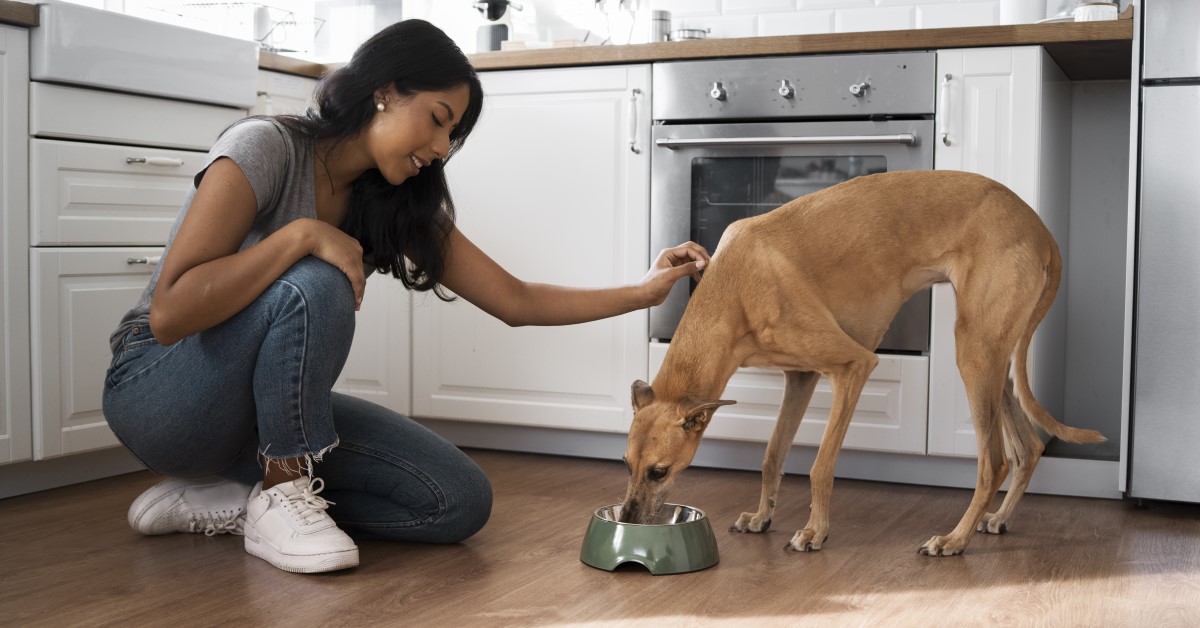Pet Diet Tips for Winter Weight Management
Keep your pet at a safe and healthy weight this winter with these effective diet tips.

Just like their human companions, pets can put on a few pounds during the winter months. This is partially due to reduced activity. Cats, dogs, and other pets are often less active when it’s cold because the weather is bad, or they’re confined indoors. If you free-feed, you may notice that your pets tend to eat more in the winter. This is a natural response to the cold and an extra effort to stay warm. Finally, animals have a gene known as the “thrifty gene” which slows down the metabolism and encourages the body to store fat for winter, resulting in weight gain.
As weight gain can increase your pet’s risk of developing conditions such as arthritis, diabetes, and heart disease, it’s crucial to properly manage your pet’s weight during the winter months. Let’s look at some effective pet diet tips for winter weight management.
Reevaluate Your Pet’s Diet
Has your pet been steadily gaining weight or is struggling with obesity? The cold winter months will often exacerbate this problem. Now is the time to reevaluate your cat’s or dog’s diet to determine if it’s really meeting his or her nutritional needs. Ensure that the diet you choose has an animal protein or meal as the first or second ingredient.
Remember that puppies and kittens require more protein and other essential nutrients than older pets to support their growth and development. Senior animals may also have unique nutritional needs. Aim for nutrient-dense foods that offer a higher proportion of nutrients in a smaller amount of food. Consider asking your vet for pet food suggestions.
Monitor Calories
Just like humans, pets can consume too many calories, especially if you fail to look at exactly what your pet is eating day-to-day. According to the Association for Pet Obesity Prevention, the recommended daily caloric intake for an average indoor pet can range based on species and weight:
Cats:
- 10 lbs.: 180 to 200 calories
Dogs:
- 10 lbs.: 200 to 275 calories
- 20 lbs.: 325 to 400 calories
- 50 lbs.: 700 to 900 calories
- 70 lbs.: 900 to 1050 calories
- 90 lbs.: 1100 to 1350 calories
Feed your pet the proper amount of calories based on its age, size, overall health status, and amount of subcutaneous fat and hair. Your vet can help you determine the appropriate caloric needs for your cat or dog.
Increase Protein Intake
While feeding your pet in moderation is key to good weight management, many cats and dogs can benefit from extra protein in the winter. Protein is an essential nutrient that helps animals maintain muscle mass and supports their overall well-being. Higher amounts of protein in your pet’s diet during the winter can also help them feel full longer, reducing their appetite for other foods and treats.
Offer Treats Sparingly
Many pets enjoy treats but too many can significantly impact their weight and health. In the winter when weight management can be a struggle, limit the number of treats you give to your cat or dog. If you must offer your pet treats, switch to a healthier option, such as carrot sticks, zucchini slices, cooked lean meats, cucumber slices, bananas, small pieces of baked potato, pumpkin, blueberries, or apple slices.
Use Pet Supplements When Necessary
Some animals have unique dietary restrictions or specific health concerns that can make it difficult for them to get the essential nutrients they need to thrive. When necessary, supplement your pet’s diet with nutrients that can help them maintain a healthy weight and promote overall wellness.
Before starting your dog or cat on any new supplements, consult with your vet to ensure that you’re making the right decision. Your vet may recommend diet supplements specifically designed to help with weight management. Some of the most commonly recommended options include chitosan and L-carnitine (an amino acid), and fish oil (rich in omega-3 fatty acids).
Create a Weight Loss Plan for Your Dog or Cat
If your pet is starting off the winter season overweight or obese, it’s important to consider an approach to weight loss. No matter what type of weight loss plan you decide on, you’ll want to take it slow. A safe weight loss for dogs is typically 1 to 5 percent of the animal’s current body weight per month, while cats can safely lose 0.5 to 1 lbs. per month.
You should approach weight loss for dogs and cats in the same way you would for yourself. This means that your pet needs to take in fewer calories than they burn to create a calorie deficit. Your vet can help you determine how much to feed your pet to promote weight loss, as well as rule out any health conditions that could be contributing to weight gain. Your pet’s weight loss plan may need to be adjusted over time.
Maintaining Your Pet’s Weight in the Winter
It’s not unusual for cats and dogs to put on a few pounds when temperatures drop, especially when it’s too cold to go outside and play. Adjusting your pet’s diet during colder winter months is an essential component of responsible pet ownership. With the right dietary changes and an extensive review of your cat or dog’s current food, you can build a diet plan that promotes good health and well-being throughout the year.
Ready to start saving money on pet wellness care?
Then take a look at Mint Wellness, the pet wellness plan that provides fast reimbursement on routine pet care. Save on vaccinations, wellness exams, preventatives, dental, and more!
Learn More


